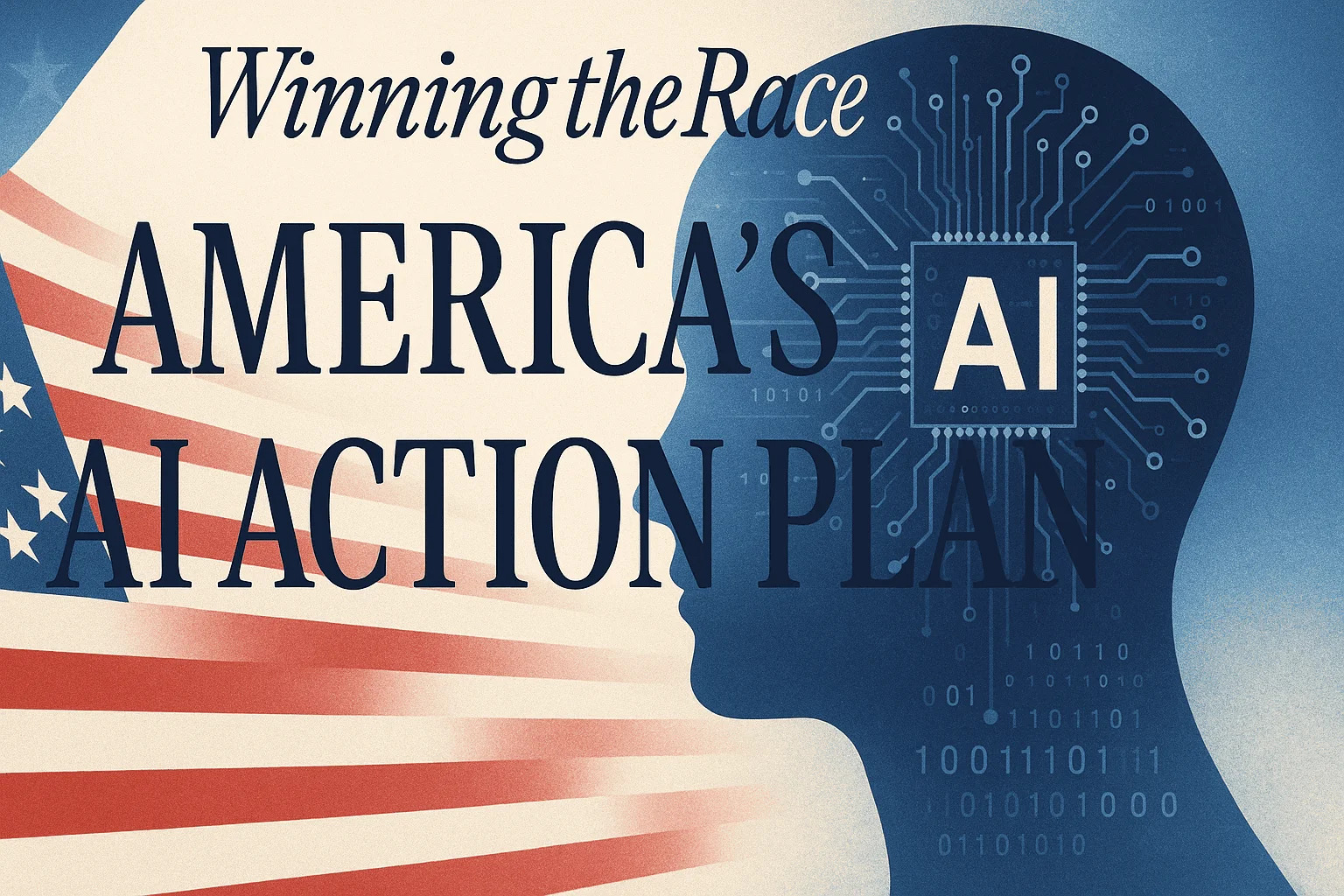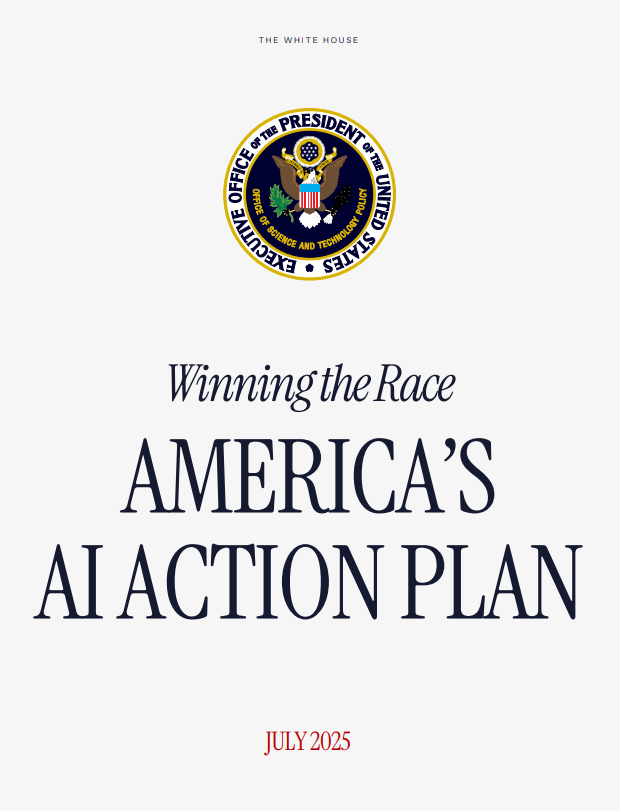In July 2025, the U.S. and China released national AI strategies with global aims: the U.S. ties AI exports to political alignment, while China promotes open cooperation with fewer conditions. These contrasting approaches reflect broader political differences and may give China an edge in global AI influence.
National-Scale AI Roadmaps and Industrial Mobilization
Both Beijing and Washington rolled out ambitious AI strategies in July 2025, signaling centralized, top-down coordination. On July 23, the U.S. released America’s AI Action Plan, detailing over 90 federal actions to accelerate innovation, build infrastructure, and assert international leadership. A few days later, at the World AI Conference in Shanghai, China unveiled its own global AI governance and action plan, emphasizing international cooperation and open-source sharing.
At first glance, the U.S. and Chinese plans appear to be quite similar. Both countries recognize that leading in AI requires heavy investments in computing infrastructure, data centers, and high-quality workforce development. The U.S. plan calls for deregulating data-center permitting, boosting grid capacity and overall energy output, and investing in domestic chipmaking and AI talent pipelines. China, continuing its long-standing industrial policy (echoing Made in China 2025), aims to subsidize research in data science and machine learning, while pushing rapid commercialization of newly developed AI products across sectors like robotics, healthcare, and autonomous vehicles.
Emphasis on Global Reach and Influence
Both strategies are globally ambitious, but this is where their differences become clear. The U.S. explicitly promotes the export of its full-stack AI technology (hardware, models, software, applications, standards) to allies and firm geopolitical partners, in order to prevent competing adversaries from free-riding on innovation. China, meanwhile, is positioning itself as a partner for Global South nations—emphasizing open technology exchange, cross-border cooperation, much less conditioned by each actor’s political alignment.
Approach to Regulation and Ideological Bias
The U.S. strategy undertakes aggressive deregulation with a strong emphasis on de-ideologizing Large Language Models (LLMs): eliminating references to Diversity, Equity, and Inclusion (DEI), one-sided views on climate change, misinformation in federal AI frameworks, and requiring federal contracts only with “ideologically objective” models, though it remains unclear who defines ‘ideological objectivity’ or how it will be measured. The strategy also rescinds additional Biden-era safeguards, favoring a hands-off, “try-first” attitude toward innovation, further catering to AI positivists.
Unsurprisingly, China maintains a tighter ideological control by the state: its Cyberspace Administration mandates LLM providers to censor content that criticizes the CCP or goes against socialist values, requires licensing before deployment, and holds companies liable for content outcomes. However, Chinese AI models appear to experience relatively limited top-down censorship beyond this ideological framework.
China is still undoubtedly behind the curve compared to the leading U.S. AI frontrunners, so its model is more centralized, with Military-Civil Fusion, direct government direction of universities, startups, and commercial labs, and state-led governance of AI priorities. This level of centralization is designed to allow a more focused and economical resource allocation and is currently both a matter of design and necessity.
The U.S. path, seemingly reliant on private-sector leadership centered around cooperation between Big Tech, universities, and venture capital, still offers policy incentives but with much lower levels of government intervention.

The Two Opposing International Approaches
China frames its global AI outreach as inclusive and non-conditional: inviting the Global South governments, research institutions, and enterprises into governance dialogues and open-source communities centered around economic cooperation and technological exchange, regardless of their geopolitical stance and unconditioned by other policies.
By contrast, the U.S. strategy hinges on alignment and political conditioning: exporting AI tech only to allies and friendly partners, tightening controls on “countries of concern” (implicitly China as the only viable global competitor in this sense), and seeking to build a political-technological bloc tied to American leadership. In many ways, such an AI strategy closely aligns with other facets of President Trump’s foreign policy.
This approach has its own merits. The U.S. aims to translate its current technological lead into lasting global dominance by exporting the AI stack, setting policy standards, and aligning allied and partner nations behind American models. To this end, the American plan references working through Commerce, State, and OSTP to create an “American AI Exports Program” delivering secure packages within 90 days.
This is meant to reinforce a normative order around American values—free speech, individual rights, ideological neutrality—but it risks emphasizing political loyalty over inclusivity. It is hard not to notice the similarities between U.S. AI and military equipment exports.
China’s approach at this moment appears to be more subtle: institutionalizing AI governance dialogues, open-source communities, and data-sharing networks, with fewer ideological strings attached. Its overt invitation to the Global South is a clear bid for soft-power influence, in line with China’s long-standing focus on this region.
By offering easier access to AI tools and markets under minimal political conditions, China may secure deeper global penetration in emerging economies. And it wouldn’t be the first such success of the East Asian power.
The Key Takeaways
While America’s new AI strategy is bold, technologically ambitious, and grounded in a desire to preserve global dominance, it overrelies on existing U.S. advantages–the chip industry, globally dominant Big Tech, and old political alliances. It shows little sign of acknowledging and adapting to rapidly shifting global dynamics.
- The technological edge is narrowing–China has systematically closed the gap on models, infrastructure, and commercialization, backed by state funding and integrated civil-military coordination. Nvidia’s CEO Jensen Huang has recently praised Chinese chipmaking developments, lauding its model of AI development as a catalyst for global tech progress, demonstrating the long way the industry has advanced in only a few years.
- The U.S. strategy assumes alignment from prospective partners. But many nations, and not only in the Global South, value sovereignty and pragmatism over political alignment and ideological conditioning, making China’s open-governance, no-strings-attached offer more attractive. Refusing to engage markets that don’t align politically risks alienating partners and limiting U.S. influence over time.
- Neglecting broader inclusion, ignoring developing markets, local researchers, and culturally diverse AI needs, may even render U.S. AI models less relevant or adoptable worldwide.
In other words, the U.S. plan risks becoming too narrow, centered on maintaining privilege rather than expanding appeal. While China’s approach involves political censorship domestically, it frames its global AI influence as open, accessible, and less ideologically conditional. This gives it a subtle but potentially durable advantage across many global markets, not only in emerging economies.”
Ultimately, U.S. policy makers could even learn something from the Chinese. They should reconsider whether exporting tech innovations solely through allied frameworks and a carrot-and-stick approach is sufficient. To remain competitive, they might need a more inclusive strategy, one that bridges not only technology but also real-world relevance, a more open type of collaboration, and trust beyond geopolitical alignment and firmly set preconditions.

